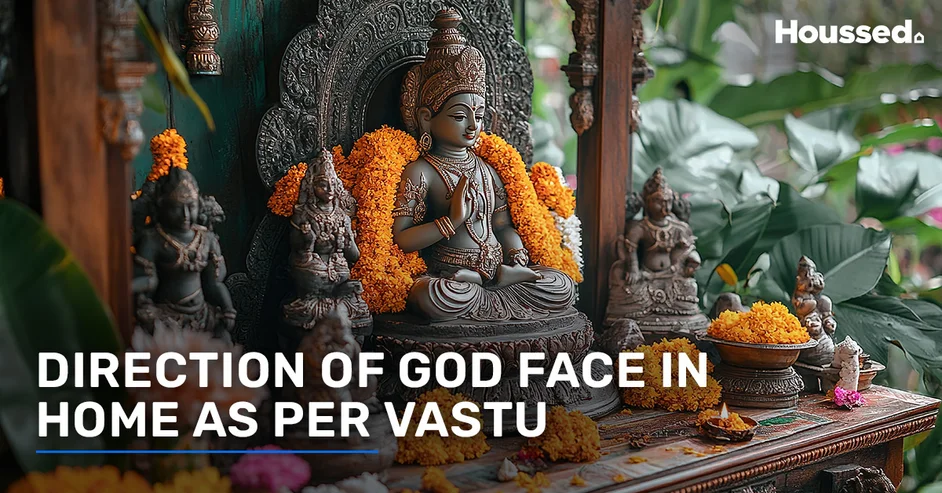Right Direction of God Face in Home as per Vastu Shastra

Vastu Shastra teaches that every compass point in your home carries a distinct vibrational quality. Therefore, the proper placement of your mandir is essential to influence harmony, prosperity, and positive energy in your household.
In this comprehensive guide, we’ll explore the ideal direction of God face in home as per Vastu, helping you create a spiritually charged space that radiates peace, devotion, and divine blessings.
Which Direction Should God Face in the Home?
According to most experts, the northeast corner (Ishan Kona) is the most sacred zone because it is believed to be the entry point for divine energies into your home.
Within that northeast space, idols should ideally face east (toward the rising sun) or west, allowing the worshipper to face east or west while praying.
Conversely, if space constraints force your mandir to the south or west, have the idol face east to maintain the auspicious flow of energy.
Some of the Essential Guidelines for Placing Your Mandir
Following these guidelines ensures the direction of God face in home as per Vastu promotes positivity, peace, and spiritual well-being.
- East-facing gods symbolise wisdom, new beginnings, and spiritual illumination.
- West-facing gods are believed to usher in abundance, contentment, and fulfilment of material desires.
- North-facing gods are believed to invite prosperity and career growth, as the north is associated with Kubera, the god of wealth.
- South-facing gods should be avoided, as the south corresponds to Yama, the god of death and dissolution.
Also Read - Vastu for Home
Best Direction for the Temple in the Home
- East: Symbolising new beginnings and spiritual growth, the East is considered ideal for placing deities such as Lord Ganesh, Goddess Durga, and Lord Kartikeya.
- West: Associated with abundance, contentment, and fulfilment of material desires, this direction is suitable for placing Lord Vishnu.
- North: Believed to attract wealth and success, the north is an ideal placement for Lord Shiva.
- Northeast: The northeast corner is governed by water and Lord Shiva. Positioning your mandir in this direction ensures spiritual growth and connects you with cosmic energy.
- Directions to Avoid: The south and southeast directions are associated with Yama, the god of death and the element of fire. Mandirs here can generate heat (literal and psychic) that disrupts harmony and invites tension.
Also Read - West Facing House Vastu Plan with Pooja Room
Vastu Tips for Mandir Placement in Small Apartments
The following tips will help ensure the direction of God face in home as per Vastu is maintained in small apartments:
- Choose a corner (northeast, east, or north) for a wall-mounted or floating shelf mandir.
- Using a portable cabinet that folds away after aarti to reclaim living space.
- Wall-mounted temples are a space-saving solution that allows you to incorporate a mandir into your home without occupying much floor area.
- Some of the space-saving mandir designs include traditional heritage mandirs, modern fusion mandirs, rustic charm mandir designs, and compact corner mandir designs.
- Foldable pooja cabinets are also a great alternative.
- Paint the pooja area in light, neutral hues, such as white, cream, or pale yellow, to expand the visual space.
- Use mirrors behind the idols to reflect light and energy.
- Keep decor simple: one or two sacred symbols, a small bell, and fresh flowers to maintain visual calm.
Also Read - North Facing House Vastu Plan With Pooja Room
Vastu for Pooja Room Facing: Do's and Don'ts
|
Do’s |
Don’ts |
|
Face east or north while praying to align with auspicious energies |
Avoid placing the mandir in a basement, bathroom, or bedroom |
|
Use wood or marble for purity and durability |
Do not store household items beneath the platform on which the idol is kept |
|
Keep the area clean, clutter-free, and well-ventilated |
Avoid placement in the south or southeast direction |
|
Light diyas or soft lamps to foster serenity |
Replace chipped or broken idols immediately to maintain sanctity |
Summary
Which Direction Should God Face in the Home?
Most experts recommend the northeast corner (Ishan Kona) as the ideal placement, as it is considered the most auspicious direction where divine energies are believed to enter and circulate within the home.
Best Direction for the Temple in the Home
- East
- West
- North
- Northeast
- Directions to Avoid: South and Southeast
Vastu Tips for Mandir Placement in Small Apartments
- Choose the northeast, east, or north corner.
- Utilise wall-mounted or foldable mandirs, portable cabinets, and compact designs, such as modern or rustic mandirs.
- Opt for light colours, mirrors, and minimal decor to keep the area spiritually vibrant and visually spacious.
Vastu for Pooja Room Facing: Do's and Don'ts
- Do's: Face east or north while praying, and use wood or marble for the mandir. Keep the area clean, clutter-free, and well-lit.
Don'ts: Avoid placing the mandir in bedrooms, bathrooms, or basements, and never in the south or southeast. Don't store items under the idol platform, and replace damaged idols to maintain sanctity.
FAQ's
Vastu Shastra generally prohibits south-facing deities because that direction attracts heavy, stabilising energies that can stifle spiritual upliftment.
Yes, Vastu Shastra states that gods can face the north direction as it is considered auspicious, which can bring prosperity.
As per Vastu, the North is more suitable for God to face, especially when the mandir is placed in the east or northeast.
The northeast corner (Ishan Kona) is best suited for a temple in a home; if unavailable, the east or north direction can be chosen. However, residents shouldn’t choose the south or southeast direction for the placement of the God.
According to Vastu Shastra, it's recommended to place the mandir on a platform or pedestal, raising it about 6 to 12 inches above the ground level.
Additionally, positioning the deity's idol at eye level, typically around 5 to 6 feet from the floor, ensures comfortable and respectful viewing during prayers.
Vastu Shastra emphasises the use of light and soothing colours in the pooja room to create a serene and harmonious environment.
Colours such as white, cream, light yellow, pale blue, and light green are considered auspicious. Avoiding dark or harsh colours helps maintain a peaceful atmosphere conducive to meditation and prayer.
Yes, you can use fresh flowers for mandir decoration; artificial flowers also offer a long-lasting and convenient alternative.
Placing the mandir near or within the kitchen is generally discouraged in Vastu Shastra. The kitchen, associated with cooking and heat, may not provide the tranquil environment ideal for worship.
Yes, keeping photographs of deities is acceptable in the pooja room, especially when space or other constraints prevent the use of idols. It's important to treat these images with the same reverence as idols.
According to Vastu Shastra, facing south during prayers is generally discouraged, as the south is associated with Yama, the deity of death, and is believed to attract negative energies.
It's recommended to face east or north while praying to align with positive energies and promote spiritual well-being.
According to Vastu Shastra, placing a mandir on a balcony is not advisable. However, if one has to create a pooja room on a balcony, ensure it is clean, covered, and located in an auspicious direction, preferably northeast, east, or north, as per Vastu.









